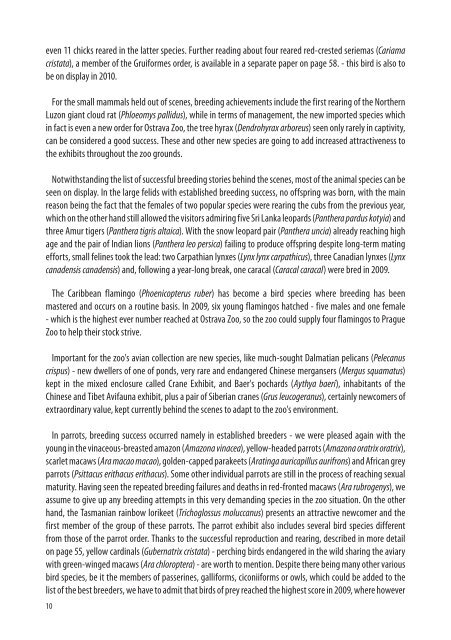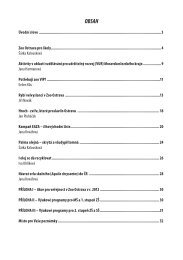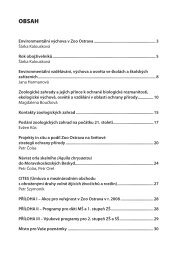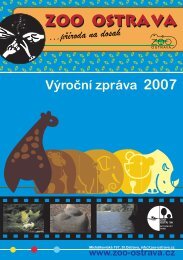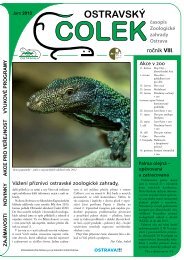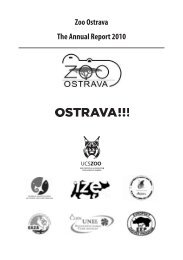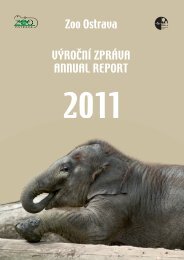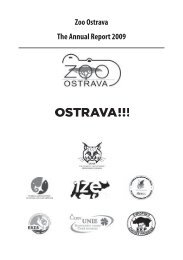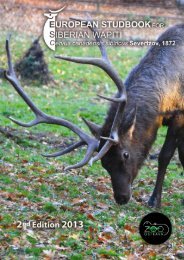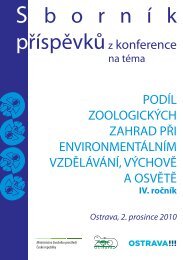výroÄnà zpráva 2009 ( 4,12 MB ) - Zoo Ostrava
výroÄnà zpráva 2009 ( 4,12 MB ) - Zoo Ostrava
výroÄnà zpráva 2009 ( 4,12 MB ) - Zoo Ostrava
- No tags were found...
Create successful ePaper yourself
Turn your PDF publications into a flip-book with our unique Google optimized e-Paper software.
even 11 chicks reared in the latter species. Further reading about four reared red-crested seriemas (Cariamacristata), a member of the Gruiformes order, is available in a separate paper on page 58. - this bird is also tobe on display in 2010.For the small mammals held out of scenes, breeding achievements include the first rearing of the NorthernLuzon giant cloud rat (Phloeomys pallidus), while in terms of management, the new imported species whichin fact is even a new order for <strong>Ostrava</strong> <strong>Zoo</strong>, the tree hyrax (Dendrohyrax arboreus) seen only rarely in captivity,can be considered a good success. These and other new species are going to add increased attractiveness tothe exhibits throughout the zoo grounds.Notwithstanding the list of successful breeding stories behind the scenes, most of the animal species can beseen on display. In the large felids with established breeding success, no offspring was born, with the mainreason being the fact that the females of two popular species were rearing the cubs from the previous year,which on the other hand still allowed the visitors admiring five Sri Lanka leopards (Panthera pardus kotyia) andthree Amur tigers (Panthera tigris altaica). With the snow leopard pair (Panthera uncia) already reaching highage and the pair of Indian lions (Panthera leo persica) failing to produce offspring despite long-term matingefforts, small felines took the lead: two Carpathian lynxes (Lynx lynx carpathicus), three Canadian lynxes (Lynxcanadensis canadensis) and, following a year-long break, one caracal (Caracal caracal) were bred in <strong>2009</strong>.The Caribbean flamingo (Phoenicopterus ruber) has become a bird species where breeding has beenmastered and occurs on a routine basis. In <strong>2009</strong>, six young flamingos hatched - five males and one female- which is the highest ever number reached at <strong>Ostrava</strong> <strong>Zoo</strong>, so the zoo could supply four flamingos to Prague<strong>Zoo</strong> to help their stock strive.Important for the zoo's avian collection are new species, like much-sought Dalmatian pelicans (Pelecanuscrispus) - new dwellers of one of ponds, very rare and endangered Chinese mergansers (Mergus squamatus)kept in the mixed enclosure called Crane Exhibit, and Baer's pochards (Aythya baeri), inhabitants of theChinese and Tibet Avifauna exhibit, plus a pair of Siberian cranes (Grus leucogeranus), certainly newcomers ofextraordinary value, kept currently behind the scenes to adapt to the zoo's environment.In parrots, breeding success occurred namely in established breeders - we were pleased again with theyoung in the vinaceous-breasted amazon (Amazona vinacea), yellow-headed parrots (Amazona oratrix oratrix),scarlet macaws (Ara macao macao), golden-capped parakeets (Aratinga auricapillus aurifrons) and African greyparrots (Psittacus erithacus erithacus). Some other individual parrots are still in the process of reaching sexualmaturity. Having seen the repeated breeding failures and deaths in red-fronted macaws (Ara rubrogenys), weassume to give up any breeding attempts in this very demanding species in the zoo situation. On the otherhand, the Tasmanian rainbow lorikeet (Trichoglossus moluccanus) presents an attractive newcomer and thefirst member of the group of these parrots. The parrot exhibit also includes several bird species differentfrom those of the parrot order. Thanks to the successful reproduction and rearing, described in more detailon page 55, yellow cardinals (Gubernatrix cristata) - perching birds endangered in the wild sharing the aviarywith green-winged macaws (Ara chloroptera) - are worth to mention. Despite there being many other variousbird species, be it the members of passerines, galliforms, ciconiiforms or owls, which could be added to thelist of the best breeders, we have to admit that birds of prey reached the highest score in <strong>2009</strong>, where however10


